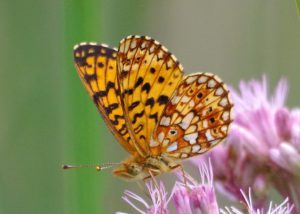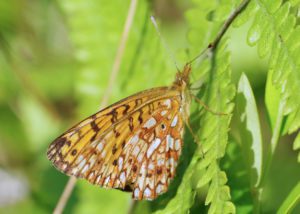Howdy, BugFans,
The BugLady’s excursions onto the prairie are always enhanced by the sight of the almost-monarch-sized (2 ½”-3 ½” wingspan) Great Spangled Fritillaries sailing along among the flowers https://bugguide.net/node/view/1995412/bgimage. They come by their names honestly – great and spangled indeed https://bugguide.net/node/view/61315/bgimage! For more information about them, see https://uwm.edu/field-station/great-spangled-fritillary/.
This summer, she’s been lucky enough to find these beautiful, also-spangled, Silver-bordered Fritillaries (Boloria selene) alternately bustling and gliding along at the margins of wetlands. They are in a different genus than the Great Spangled – Boloria are called the lesser fritillaries – and with 1 ½” to 2” wingspans, they are noticeably smaller. Selene was goddess of the moon in ancient Greek mythology; a previous scientific name is Brenthis myrina, and an old common name for this species is “little myrina,” which the BugLady doesn’t understand, because myrina refers to the Amazon mythology.

Fritillaries are in the brush-footed butterfly family Nymphalidae – butterflies whose first pair of legs is reduced and “brushy” and who walk around on their second and third pairs of legs.
Silver-bordered Fritillaries are found around marshes, sedge meadows, and bogs across the northern half of the US and into Canada (in the southern part of their range they may live at higher elevations), and at another location – more about that in a sec. They are homebodies that do not disperse enthusiastically from the enclaves where they are found.
Males patrol for females. Females lay eggs on violets, their caterpillars’ sole food plants, though sometimes she puts her eggs on the ground or on grasses near violet plants, and then her offspring must find their first meal for themselves. They don’t have a favorite violet – whatever’s growing nearby works for them – and they don’t appear to use non-native violet species. Adults nectar on members of the composite, pea, and milkweed families.
They produce at least two broods each year, and the final brood overwinters as caterpillars, sheltered on the ground, in a stage of dormancy. Some of these overwintering larvae are half-grown when they tuck in for the winter, and some are fairly recently hatched, so the appearance of adult butterflies is somewhat staggered after they awake, resume feeding, and complete their metamorphosis in spring, a phenomenon that Scudder investigated in 1889.
Silver-bordered Fritillary don’t adapt rapidly to change, and their populations are decreasing across their range. Their numbers probably rose as European settlers whacked back the endless forests of the eastern US, creating favorable habitat. But the resulting agricultural landscape was not friendly to them either, because wetlands were drained (so the land could be “more productive”), and because their violets were plowed up or were pushed out by the European crops. According to Massachusetts Butterflies, roadside ditches are emerging as important habitat for Silver-bordered Fritillaries in that state. Food specialists are, by nature, closer to the abyss than are generalists.

Spraying for gypsy moths threatens them, climate change is thinning populations of this northern-oriented species across the southern edge of its range, and they continue to be bothered by habitat loss and habitat fragmentation.
If you google Boloria selene, you’ll also get hits from across The Pond, where the Silver-bordered Fritillary is known as the Small Pearl-bordered Fritillary (as one source said, “from the series of ‘pearls’ that run along the outside edge of the underside of the hindwing”). It’s found from Great Britain through Europe and into Asia, and, alas, its populations are declining abroad, too, due to habitat change brought by agriculture.
Like the American members of the species, the Small Pearl-bordered Fritillary is a fairly sedentary butterfly that doesn’t travel far from its natal wetland. When habitat gets fragmented, populations get isolated, and genetic diversity diminishes. Research indicates that when siblings of this species mate – a possibility that becomes more likely with isolation – their offspring aren’t viable.
Apropos of nothing, as the BugLady’s Dad used to say, the BugLady found this cute little bug while doing an unrelated search https://bugguide.net/node/view/22991/bgimage (she has photographed the adult, which is also awesome!), and this blog.whose first article is about insect use of swamp milkweed http://www.hiltonpond.org/ThisWeek210811.html.
Kate Redmond, The BugLady
Bug of the Week archives:
http://uwm.edu/field-station/category/bug-of-the-week/
